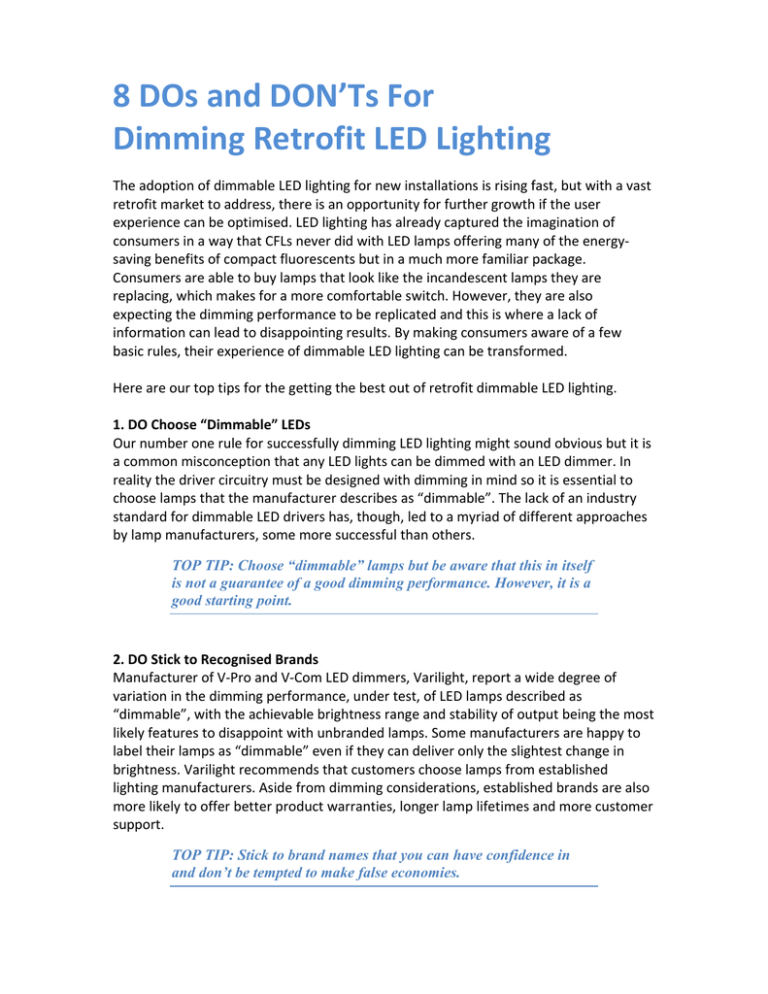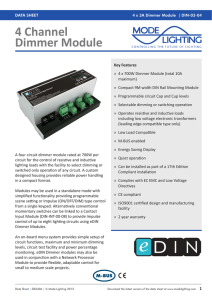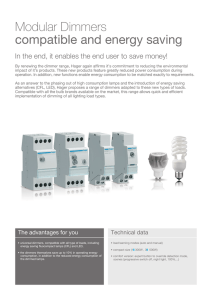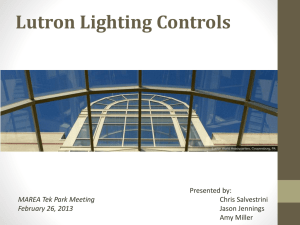DOs and DON`Ts for Dimming LEDs
advertisement

8 DOs and DON’Ts For Dimming Retrofit LED Lighting The adoption of dimmable LED lighting for new installations is rising fast, but with a vast retrofit market to address, there is an opportunity for further growth if the user experience can be optimised. LED lighting has already captured the imagination of consumers in a way that CFLs never did with LED lamps offering many of the energy‐ saving benefits of compact fluorescents but in a much more familiar package. Consumers are able to buy lamps that look like the incandescent lamps they are replacing, which makes for a more comfortable switch. However, they are also expecting the dimming performance to be replicated and this is where a lack of information can lead to disappointing results. By making consumers aware of a few basic rules, their experience of dimmable LED lighting can be transformed. Here are our top tips for the getting the best out of retrofit dimmable LED lighting. 1. DO Choose “Dimmable” LEDs Our number one rule for successfully dimming LED lighting might sound obvious but it is a common misconception that any LED lights can be dimmed with an LED dimmer. In reality the driver circuitry must be designed with dimming in mind so it is essential to choose lamps that the manufacturer describes as “dimmable”. The lack of an industry standard for dimmable LED drivers has, though, led to a myriad of different approaches by lamp manufacturers, some more successful than others. TOP TIP: Choose “dimmable” lamps but be aware that this in itself is not a guarantee of a good dimming performance. However, it is a good starting point. 2. DO Stick to Recognised Brands Manufacturer of V‐Pro and V‐Com LED dimmers, Varilight, report a wide degree of variation in the dimming performance, under test, of LED lamps described as “dimmable”, with the achievable brightness range and stability of output being the most likely features to disappoint with unbranded lamps. Some manufacturers are happy to label their lamps as “dimmable” even if they can deliver only the slightest change in brightness. Varilight recommends that customers choose lamps from established lighting manufacturers. Aside from dimming considerations, established brands are also more likely to offer better product warranties, longer lamp lifetimes and more customer support. TOP TIP: Stick to brand names that you can have confidence in and don’t be tempted to make false economies. 3. DO Read the Label To deliver a true retrofit comparison with incandescent lighting it is important to consider the brightness range. Significant advances have been made in recent years in LED lighting technology, leading to far higher lumens per watt being achieved, even for halogen‐mimicking, warm‐white lamps where lamp output is often compromised for the more familiar incandescent hue. There is little point in connecting a dimmer to an LED light if it is quite dim enough already and so this progress in the brightness of retrofit LED lamps has made dimming much more relevant. Brighter lamps can provide customers with a greater dimming range. TOP TIP: Read the label and select the dimmable lamps with the highest maximum lumen output. 4. DO Ask Manufacturers About Compatibility Most established lighting brands publish compatibility data on their websites. Dimmer switches from various brands are tested with various loads and the lamp performance graded. These grades are a useful reference point and can help in choosing a dimmer. It can be confusing though, when navigating the websites of international brands, to find dimmers listed that are not available in the UK. If in doubt contact the company to ask about their recommendations. TOP TIP: Manufacturers want customers to experience the full potential of their lamps and will often be happy to recommend the best dimmer switch to use. 5. DON’T Use a Standard Dimmer Some lamps manufacturers may boast that their dimmable LED lighting can be controlled using a standard dimmer, but where this claim is borne out, it is likely to only be when some very narrow criteria are met. Standard dimmers will be under‐loaded in most LED applications, exacerbating flickering and strobing effects, which in turn, can drastically shorten lamp lifetimes. Nor are standard dimmers equipped to exploit the full brightness range, resulting in a disappointing user experience. TOP TIP: Take claims of compatibility with standard dimmers with a pinch of salt. 6. DO Choose a Dimmer Designed for LED Lighting Sophisticated dimmers are available to deliver the best possible performance from dimmable LED lighting. Some, such as Varilight’s V‐Pro LED dimmer, have several dimming modes on board to enable smooth dimming across the diverse driver technologies in the market. The brightness output a lamp produces from the same power input varies markedly between brands. For this reason, Varilight has included an adjustable minimum brightness setting to enable the user to access the full brightness range of a given lamp. An adjustable minimum brightness also ensures that any instability a lamp might exhibit at its lowest level of illumination can be avoided. TOP TIP: Dedicated LED dimmers are equipped to exploit an LED lamp’s full dimming potential, better replicating the dimming behaviour of an incandescent lamp. 7. DON’T Buy Your Lights Without First Selecting A Dimmer Like all dimmer switches, those designed for LED lighting have minimum and maximum load recommendations. Design your lighting installation to ensure you don’t exceed the maximum load of the dimmers available. Splitting the load across more than one dimmer could provide a solution and give greater control by allowing light levels to be zoned within a multi‐functional space. Until recently it was difficult to find a dimmer capable of controlling more than 100W of LED lighting but the launch of Varilight’s V‐ Com series has opened up the possibility of dimming much larger LED loads, up to 600W. TOP TIP: It’s important to select a dimmer capable of controlling the total wattage and quantity of the lamps you want to dim. 8. DO Read the Instruction Leaflet LED dimmers often come with features designed to enhance their performance but you may need to program the dimmer to access them. Don’t be tempted just to “plug and play” because you may be missing out of features that will give greater expression to your lighting. For example, enhanced scene‐setting features within Varilight’s V‐Pro remote control dimmers can be unlocked by using the dedicated “LightScene” handset. Aware of our entrenched reluctance to read product literature, some manufacturers have released “how‐to” videos on their websites. TOP TIP: Read the instruction leaflet or risk missing out on features and benefits.




